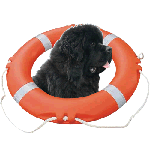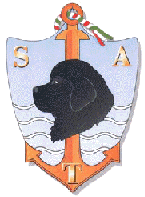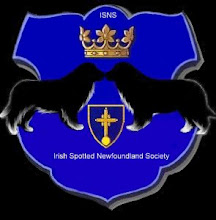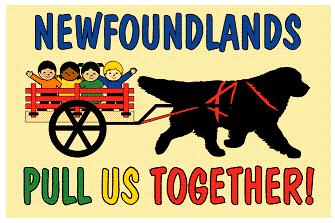Monday, May 31, 2021
Remembering Sergeant Gander
(Veterans Affairs - Canada)
Sergeant Gander was a Newfoundland dog, and was raised by the Hayden family on the airport base in Gander, Newfoundland. He was a friendly dog who loved playing with children. He pulled them on their sleds and kids watched him drool—Newfoundland dogs drool a lot!—He enjoyed living on the base but spent too much time on the runways, trying to catch the planes as they came in to land.
One day, because he was growing to be so large, the Hayden family decided to give the playful dog to the Royal Rifles of Canada Regiment. He quickly became a good friend and mascot for the soldiers of the regiment.
Taking care of Gander was a pleasant duty. During wartime the friendship of a dog reminded many of the men of pets and family at home. Gander was a mascot, but he was also seen as a fellow soldier with a job to perform. He would bark and nip at the legs of the enemy, scaring them away. One night in December 1941, Gander showed his true courage.
In 1941, the Royal Rifles of Canada Regiment was sent to Hong Kong to defend the land from an enemy invasion. The men didn’t want to leave Gander behind, so they gave him the rank of “Sergeant” and he boarded the troopship with his fellow soldiers.
During his time as their mascot, Gander proved his value more than once. There are at least three documented instances of Gander protecting the troops. The first was when a wave of attackers landed on the beach and Gander rushed at them barking and charging at their legs. The second instance occurred at night. There was a group of injured Canadians laying on the road and as a group of Japanese soldiers advanced towards them, Gander flew at them, causing them to change direction.
He was a smart dog—he knew what a grenade was and how it could hurt people. That night, Gander saw a grenade tossed near a group of wounded Canadian soldiers. He ran to it, took it, and rushed away with it. The grenade exploded and Gander was killed. But he had saved the lives of the seven soldiers! Those men never forgot Sergeant Gander.
Tuesday, May 25, 2021
Satchie - Happy Birthday In Heaven
Happy Birthday in Heaven
"I wish you were here today
even for just a little while
so I could say Happy Birthday 'Satchie'
and see your beautiful smile.
The only gifts today will be
the gifts you left behind;
The laughter, joy and happiness...
precious memories...the best kind.
Today I'll do my very best
to try and find a happy place...
struggling to hide my heavy heart
and the tears on my face.
I'll sit quietly and look at your picture
thinking of you with love;
hoping you're doing ok
in Heaven up above.
May the angels hold you close and
sing you a happy song...
and I'll be sending wishes to you
today and all year long."
Bless you Satchie, my compass star.
Saturday, May 22, 2021
Larry The Newfoundland Dog - Saving Lives In A Different Way
(By Devin Rokyta, College of Veterinary Medicine - Washington State University)
Larry is the typical Newfoundland dog – big, cuddly, and friendly.
He is a social butterfly and is always up for a tasty treat, napping, or
swimming. He also loves his frequent visits to Washington State University’s
Veterinary Teaching Hospital, where, whether he knows it or not, he is saving
the lives of other dogs as a volunteer blood donor. “Everybody at the veterinary
hospital knows his name and wants to give him attention,” said Sarah Huston, who
is Larry’s owner, best friend, and a licensed veterinary technician at the
hospital. “I don’t know if he knows he is the life-saver he is, but he knows he
is doing good stuff when he goes to the hospital.”
Since the donor program began more than three decades ago,
the veterinary hospital’s blood bank has made it
possible to perform thousands of transfusions and save the lives of countless
dogs and cats. “Last week, we probably would have had two patients die without
using blood,” said Dr. Jane Wardrop, director of the blood bank and the
veterinary hospital’s Clinical Pathology department. “It would be very sad to
not be able to supply these animals with what they need. This program saves
lives. It really does.”
Wardrop typically works with a team of four veterinary
students and a donor base of 20 dogs and a handful of cats. The students are
trained to manage donors and handle collections and processing. Each hopeful
volunteer must go through a litany of tests to ensure it is healthy and that it
has the proper temperament. Dogs must be 1-6 years old, weigh at least 60 pounds
and be able to lie still on a table for 10 minutes while blood is being
collected. Cats, which are sedated during collections, must be 1-6 years old and
weigh at least 10 pounds. Pet owners are asked to commit to the program for at
least two years. Dog volunteers typically make donations every two months, while
cats can donate every three months. “We want dogs that are happy to come here,
that look forward to it, that wag their tail when they go in that transfusion
room,” Wardrop said.
“They get a lot of praise and belly rubs – stuff you
wouldn’t do with a person giving blood.” In addition to knowing their pet is
saving the lives of other dogs and cats, pet owners also get a handful of perks,
including free Purina dog or cat food thanks to the program’s longstanding
partnership with Nestlé Purina PetCare. “Purina has been gracious enough to
provide their food for donors in our program, and we can’t thank them enough for
their partnership and help with this program,” Wardrop said. Avi Shaprut,
veterinary communications manager at Nestlé Purina PetCare, said Purina is proud
to have the opportunity to provide high-quality food to donors. “These owners
have committed their pets to serving a higher purpose in providing lifesaving
blood to help other pets survive during times of dire need,” Shaprut said. “Our
Pro Plan diets provide protein and nutrients to help these heroes thrive and be
able to donate again at a suitable time.
As such, this now longstanding
partnership with this impactful program just makes sense.” The food is just a
small thank you to the blood donors and their owners who make such a difference.
“A lot of our critical care and emergency patients,” Huston said, “they wouldn’t
go home to their families without these life-saving donations that our blood
donors provide.”
Thursday, May 13, 2021
Meet The Newfoundland Pony
(Hallie Cotnam · CBC News)
"A small farm in Perth, Ont., is taking big steps to rescue a historically significant pony breed with the birth of two new foals.
Newfoundland ponies descended from original stock brought to the island by British settlers to pull wagons and haul firewood, timber and kelp. They're distinct from other breeds in that their coat is especially thick and their front legs are closely set.
'They … have survival traits that have evolved from living on such a rugged, harsh island,' said Korrine Affleck, co-owner of Willow Creek Stables. 'They've got very small, short, furry ears that protect them against frostbite and black flies.'
Affleck and her partner Wayne Jordan were pleased to announce the birth last week of a colt named Touton, or officially, Touton of Jellybean Row.
'Touton is essentially a fried dough pancake … usually served with molasses and sometimes with 'scrunchions,' said Affleck, describing a Newfoundland specialty that was the inspiration behind the pony's name. Scrunchions are bite-size pieces of fried pork fat.
Touton joins Georgie, a filly born on the farm just last month and named after artist Clifford George, himself a devoted supporter of the Newfoundland pony breed.
The Willow Creek Stables herd now numbers 15, one of the largest in Canada.
'The latter part of the 20th century has not been kind to our Newfoundland pony,' said Affleck.
Tractors, snowmobiles and ATVs rendered them obsolete. Changes to open grazing laws in the 1970s meant they could no longer forage at will. Instead, pony owners had to buy hay and ship it in from Nova Scotia.
From an estimated population of about 12,000 in 1970, 'the ponies dropped to fewer than 100 by 1980,' Affleck told CBC Radio's Ottawa Morning, describing how the unwanted ponies were sold to meat processing plants in Quebec, then shipped to Belgium and France for human consumption.
According to Affleck, there are now just a few hundred Newfoundland ponies found in pockets across Canada. The breed is listed as 'critically endangered' by several groups including Rare Breeds Canada, The Livestock Conservancy and Equus Survival Trust.
In 1997, the government of Newfoundland and Labrador recognized the pony as an official heritage animal and they're now protected. But there are now so few remaining that the entire breed is in jeopardy, according to Affleck, who's also chair of the re-homing committee for the Newfoundland Pony Society, dedicated to protecting the species.
'They are critically, critically endangered. People think about endangered species and they think of tigers. But we've got 3,000 tigers worldwide. These Newfoundland ponies, there are only a few hundred remaining and only a couple hundred of breeding age.'
Newfoundland ponies are 'very docile, intelligent and willing,' said Affleck. 'They are much more like dogs. They're very curious. As soon as a person comes to the farm, they've got to come over and meet you and sniff you and basically demand attention just like a dog would.'
Affleck and Jordan offer free COVID-19-friendly barn visits in a bid to build awareness about the breed. They do accept donations, but their real hope is that people 'fall in love with them and maybe step in [and] offer a home to a pony.'
In an interesting twist, Affleck's abiding affection for the pony breed led to romance of the two-legged variety. She had been tracking down the progeny of a Newfoundland pony she had acquired, and got in touch with an owner.
'I called Wayne out of the blue one day at his work. I asked him if I could come and take a DNA sample of his pony, which is essentially a hair sample, and he agreed. And the rest is history.'"
Saturday, May 8, 2021
Subscribe to:
Posts (Atom)















































